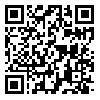Thu, Oct 23, 2025
Volume 10, Issue 2 (Spring 2024)
Caspian J Neurol Sci 2024, 10(2): 102-110 |
Back to browse issues page
Ethics code: IR.DU.REC.1401.006
Download citation:
BibTeX | RIS | EndNote | Medlars | ProCite | Reference Manager | RefWorks
Send citation to:



BibTeX | RIS | EndNote | Medlars | ProCite | Reference Manager | RefWorks
Send citation to:
Rahimi M, Goudarzi I, Rohampour K. Effect of Fluvoxamine on Electrophysiological and Behavioral Alterations of Rats With Depression. Caspian J Neurol Sci 2024; 10 (2) :102-110
URL: http://cjns.gums.ac.ir/article-1-684-en.html
URL: http://cjns.gums.ac.ir/article-1-684-en.html
1- School of Biology, Damghan University, Damghan, Iran.
2- Department of Physiology, School of Medicine, Guilan University of Medical Sciences, Rasht, Iran. ,rohampour@gums.ac.ir
2- Department of Physiology, School of Medicine, Guilan University of Medical Sciences, Rasht, Iran. ,
Abstract: (1187 Views)
Background: Depression is a serious mental illness with symptoms such as worry, disturbed sleep and appetite, lack of interest or pleasure, and persistent sorrow.
Objectives: This study aims to assess the effect of fluvoxamine (FLX) on behavioral and electrophysiological alterations of the posterior cingulate cortex (PCC) and the hippocampus in rats with depression.
Materials & Methods: Thirty-two albino rats (weighing 250–300 g) were divided into four groups; control (sham), chronic mild stress (CMS), FLX, and CMS+FLX. The CMS was induced by applying different stressors for 3 weeks. Intraperitoneal injection of FLX (25 mg/Kg) was performed daily for 14 days in the treatment group. Depressive-like behaviors were assessed, and local field potentials (LFP) from the hippocampus and the PCC were recorded.
Results: FLX effectively reduced depressive-like behaviors in rats with CMS (P≤0.05). Additionally, depression-induced alterations in LFP were observed in the hippocampus and the PCC. Depression reduced the power of delta and theta bands and increased the hippocampal low-gamma band power (P≤0.05). In the PCC, depression increased the power of delta and low-gamma bands and reduced the power of the alpha band (P≤0.05).
Conclusion: FLX reduce depression-like behaviors in the animal model, possibly through affecting electrophysiological activity of the hippocampus and the PCC.
Objectives: This study aims to assess the effect of fluvoxamine (FLX) on behavioral and electrophysiological alterations of the posterior cingulate cortex (PCC) and the hippocampus in rats with depression.
Materials & Methods: Thirty-two albino rats (weighing 250–300 g) were divided into four groups; control (sham), chronic mild stress (CMS), FLX, and CMS+FLX. The CMS was induced by applying different stressors for 3 weeks. Intraperitoneal injection of FLX (25 mg/Kg) was performed daily for 14 days in the treatment group. Depressive-like behaviors were assessed, and local field potentials (LFP) from the hippocampus and the PCC were recorded.
Results: FLX effectively reduced depressive-like behaviors in rats with CMS (P≤0.05). Additionally, depression-induced alterations in LFP were observed in the hippocampus and the PCC. Depression reduced the power of delta and theta bands and increased the hippocampal low-gamma band power (P≤0.05). In the PCC, depression increased the power of delta and low-gamma bands and reduced the power of the alpha band (P≤0.05).
Conclusion: FLX reduce depression-like behaviors in the animal model, possibly through affecting electrophysiological activity of the hippocampus and the PCC.
Keywords: Depression, Hippocampus, Posterior cingulate cortex, Fluvoxamine, Local field potential recording
Type of Study: Research |
Subject:
General
Received: 2023/05/8 | Accepted: 2023/06/26 | Published: 2024/04/1
Received: 2023/05/8 | Accepted: 2023/06/26 | Published: 2024/04/1
Send email to the article author
| Rights and permissions | |
 | This work is licensed under a Creative Commons Attribution-NonCommercial 4.0 International License. |






